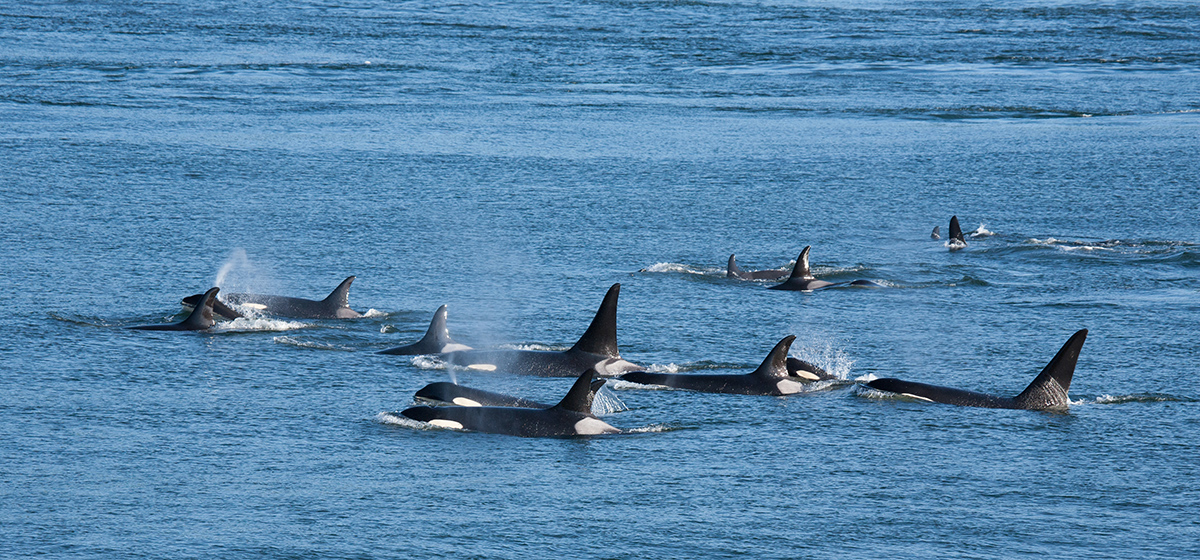Messages from Executive Director and Boards
From the Director

When we published the last State of the Sound report in 2019, we could not have foreseen what was to come: a global pandemic, a social justice reawakening, terrifying wildfires that poisoned the air in Puget Sound, a contested election, and a heat dome that sent June temperatures in the Puget Sound region soaring over 100F, killing humans and marine creatures alike. These challenges – most of them of our own making – have tested us over the past two years.
Perhaps it is not surprising that the 2021 State of the Sound report also mainly presents challenges. Very few of our indicators met their 2020 targets. The Southern Resident orca population hovers at 74 animals, and Chinook salmon populations show no signs of recovery. Marine water quality continues to decline.
However, these past two years also have shown us that we are resilient, even in the face of loss. We are finding ways to navigate the pandemic, and to reach out to those who need some help doing so. Many of us are grappling in our own ways with the long-overdue reckoning of the social justice movement. And hundreds if not thousands of people continue to pour their time, energy, hearts, and souls into Puget Sound recovery.
This agency’s mission is to accelerate Puget Sound recovery. It will take all of us – all who live in and care about this special place – working together to restore Puget Sound to resilience. We know that national and global action is necessary to combat climate change. In the meantime, Puget Sound needs us to redouble our efforts to protect and restore habitat, clean up the water, cool our rivers and streams, and ensure there is local food to harvest. If we don’t, we risk losing our salmon and orca as the climate warms and our population inexorably grows. With their loss, we humans lose something of ourselves, too.
Regional decision-makers made the right decisions for Puget Sound often enough over the past 10 years that some of our habitat indicators show signs of progress. That trend must continue, but it’s only going to get more difficult as we face the very real need to provide affordable housing, transportation, and other services for human beings here in this special place. We must support regional decision-makers and work together to find solutions to ensure people of all walks of life can continue to enjoy the bounty of the Puget Sound region.
We know what we need to do for Puget Sound. Let’s do it.
Leadership Council letter
We are proud to present the 2021 State of the Sound report.
This past year has been extraordinary. Unusually extreme weather and climate events have struck nearly every state, from the coasts to the heartland. The COVID-19 pandemic continues to inflict a devastating toll on our public health and our communities. The adverse economic effects have been nearly as significant. As the pandemic raged, racial injustice once again sparked outrage across our land.
Even in these challenging times, the Puget Sound region remains an attractive place to live. Our economy and population continue to grow, with upwards of 7.7 million people now calling Washington State home and the Seattle metro area alone recently surpassing Atlanta as the tenth largest regional economy in the U.S. Most analysts forecast continued economic growth in the region, and with it a growing population. Unabated, these changes increase impacts to our land, water, air, and wildlife.
The connection between a healthy Puget Sound and human wellbeing is clear. Recent studies strongly demonstrate that Puget Sound residents of all races and ethnicities are finding happiness, tranquility, and recreational opportunities in Puget Sound’s green and blue spaces. We are fortunate to live in a place with abundant and unparalleled access to mountains, forests, rivers, parks, and beaches. It is incredibly important that we increase opportunities for everyone – from every background – to enjoy the restorative and sustaining green and blue open spaces of this remarkable place we call home.
How, though, are these special places faring? We look to our Puget Sound Vital Signs for a status check on the health of the ecosystem around us. Unfortunately, most of our Vital Sign indicators are static or slowly getting worse. Few meet – or even approach – the recovery targets we set for them. Notably, no Species and Food Web indicators have improved and some of our most iconic species – including Southern Resident Orcas and Chinook salmon – are far from recovery targets with trajectories heading in the wrong direction. Many indicators related to marine and freshwater quantity and quality are also worsening, and the impacts of climate change will further hasten downward trends.
Indeed, this summer’s heat wave in the Puget Sound region showcases the unprecedented threat of climate change. The Seattle area rarely experiences triple digit temperatures: prior to this summer, we’d only reached the 100-degree mark three times in the past 117 years. In late June, however, we witnessed three consecutive days of high temperatures exceeding 100 degrees Fahrenheit. This extraordinary heat literally cooked more than a billion of shellfish alive on exposed tide lands. The aggregate impact on wildlife is not currently known.
Despite these ominous signs, there remains cause for some cautious optimism: During the past two years, conversion of forests and ecologically important lands slowed down. Investments in restoration continue to improve degraded habitats in many Puget Sound watersheds. Salmon runs in Hood Canal are improving— a happy deviation from populations in other parts of the Sound. In the context of increasing climate impacts and continued regional growth and development, reversing negative trends is a notable accomplishment. Our task now is to build on – and rapidly accelerate – the positive trends.
Let us be crystal clear that we, the Puget Sound Partnership’s Leadership Council, believe that lasting, durable recovery of Puget Sound is possible. We offer the following as bold, decisive actions we must take over the next two years to support a resilient Puget Sound ecosystem for people and for the creatures with whom we share this special place:
Work with the Governor’s Office to make Puget Sound and salmon recovery the cornerstone of Governor Inslee’s third term;
Establish a new funding source – such as a Puget Sound Recovery Fund – and significantly increase funding for habitat restoration, road retrofits to manage stormwater, and wastewater treatment systems to protect shellfish beds;
Bring the State Growth Management Act and Shoreline Management Act into the 21st century with a Net Ecological Gain standard, and other updates that will reverse historic habitat loss;
Broaden and deepen the coalition demanding a healthy Puget Sound, including annually convening Puget Sound Day on the Sound, to highlight Puget Sound recovery needs and generate political momentum for necessary decisions and investments; and
Implement systems of accountability, performance measurement, and adaptive management to ensure our investments in Puget Sound recovery deliver the transformational results we need.
Climate change and explosive population growth are upon us. Nevertheless, we’ve experienced signals that the system can indeed respond when we take decisive action and build toward a resilient ecosystem. With our dedicated network of partners, there has never been a better or more urgent time to act.
Jay Manning, Chair
Stephanie Solien, Vice Chair
Will Hall
Russell Hepfer
Deborah Jensen
Dennis McLerran
Toby Murray

Comments from the Science Panel
We must act decisively to achieve our mutual interests in a Puget Sound that sustains a healthy economy, ecology, and environment for all.
Our world has changed since the 2019 State of the Sound report. The continued impacts of climate change and a transition in national leadership have shifted how we must approach Puget Sound recovery. In particular, a heightened focus on social justice has brought about a new emphasis on the human dimensions to the recovery project. The pace of climate change and its associated impacts increases the need for a resilient ecosystem and increases the scale and scope of needed actions and protections. Current circumstances amount to a critical turning point; the recent pandemic has shown that such situations can bring about wholesale modifications in behaviors and policies.
Creative thinking and bold actions are urgently required to make the transformative gains we seek in the Puget Sound socioeconomic system; this is a key overall theme of the Science Panel’s comments. While the road ahead remains challenging, we must redouble our commitment to forge a future Puget Sound that embodies the scientific principles, ecological relations, and human values that provide the foundation for resilience, sustainability, and equity.
Despite some impressive gains in several areas of the recovery project, we have yet to see truly transformative changes in the Puget Sound ecosystem. Some dimensions of the ecosystem are improving, but at the whole system level we have not seen the needle move as much. For that to happen, we need to make hard choices about the future we want. To help make the decisions that will lead to system-level change under current projections for climate change and population growth, we are investigating alternative future scenarios. Advances in modeling that better address uncertainties allow us to project the impacts of our actions on ecosystems, how communities make choices, and policy decisions in a formal way. This effort will provide valuable insights on potential future conditions to complement our reflections on the observed impacts of past actions.
To be transformative we must recognize and embrace ecosystem recovery as a human as well as ecological process. A critical component of ecosystem recovery is ensuring human wellbeing in all its dimensions. Puget Sound recovery requires acting collectively on a large scale over an extended period of time towards ends that may not be realized soon afterwards. Part of any successful strategy for Puget Sound recovery will be achieving buy-in from a broad coalition of residents, stakeholders, and politicians — it gets to the very core of understanding what motivates individuals and groups to act in their short-term but also long-term interests, and at both local and broader scales.
We are not going back to a past Puget Sound. We are moving forward into a future that must establish resilience in the Puget Sound ecosystem. Resilience depends on three components: diversity, connectivity, and adaptation. Promoting these three components in our recovery actions will help create resilience. Resilience is also a management strategy as well as an attribute of a system, encouraging us to adopt adaptive rather than rigid tactics. The Partnership’s Alternative Futures Project will assess the strategies that should prove successful given factors such as a warming climate and population growth. Resilient strategies should be part of our interventions in ecosystems, to allow us to enhance the chances of a healthy Puget Sound under a broad range of possible future human activities on ecosystems.

